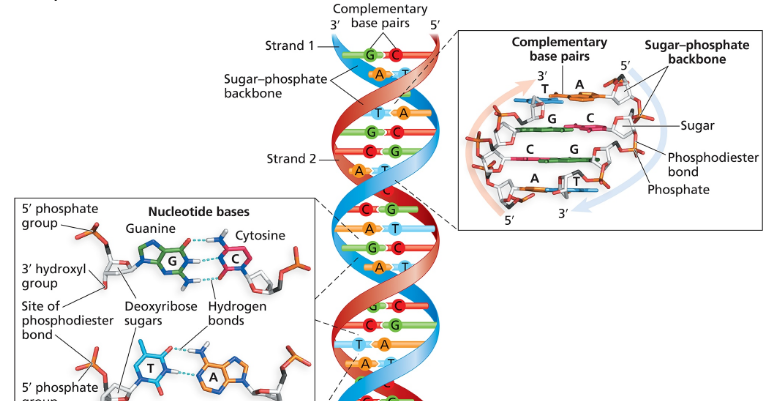The principles of complementary base pairing and antiparallel polarity of nucleic acid strands in a duplex are universal for the formation of nucleic acid duplexes. What is the chemical basis for this universality?
Table of contents
- 1. Introduction to Genetics51m
- 2. Mendel's Laws of Inheritance3h 37m
- 3. Extensions to Mendelian Inheritance2h 41m
- 4. Genetic Mapping and Linkage2h 28m
- 5. Genetics of Bacteria and Viruses1h 21m
- 6. Chromosomal Variation1h 48m
- 7. DNA and Chromosome Structure56m
- 8. DNA Replication1h 10m
- 9. Mitosis and Meiosis1h 34m
- 10. Transcription1h 0m
- 11. Translation58m
- 12. Gene Regulation in Prokaryotes1h 19m
- 13. Gene Regulation in Eukaryotes44m
- 14. Genetic Control of Development44m
- 15. Genomes and Genomics1h 50m
- 16. Transposable Elements47m
- 17. Mutation, Repair, and Recombination1h 6m
- 18. Molecular Genetic Tools19m
- 19. Cancer Genetics29m
- 20. Quantitative Genetics1h 26m
- 21. Population Genetics50m
- 22. Evolutionary Genetics29m
7. DNA and Chromosome Structure
DNA Structure
Problem 8b
Textbook Question
The following figure (Figure 1.6) presents simplified depictions of nucleotides containing deoxyribose, a nucleotide base, and a phosphate group. Use this simplified method of representation to illustrate the sequence 3'-AGTCGAT-5' and its complementary partner in a DNA duplex.

What kind of bonds join the C in one strand to the G in the complementary strand?
 Verified step by step guidance
Verified step by step guidance1
Understand the structure of DNA: DNA is a double-stranded molecule where each strand is composed of nucleotides. Each nucleotide consists of three components: a deoxyribose sugar, a phosphate group, and a nitrogenous base (A, T, G, or C). The strands are antiparallel, meaning one runs 3' to 5' and the other runs 5' to 3'.
Illustrate the given sequence: Write the sequence 3'-AGTCGAT-5' as a single strand. Label the 3' and 5' ends to indicate the directionality of the strand.
Determine the complementary strand: Use base-pairing rules to find the complementary sequence. Adenine (A) pairs with Thymine (T), and Guanine (G) pairs with Cytosine (C). Write the complementary strand in the opposite direction (5' to 3').
Identify the bonds between complementary bases: The bases in the two strands are joined by hydrogen bonds. Specifically, Cytosine (C) and Guanine (G) are connected by three hydrogen bonds, while Adenine (A) and Thymine (T) are connected by two hydrogen bonds.
Illustrate the DNA duplex: Draw the two strands of DNA with their complementary base pairs connected by hydrogen bonds. Ensure the antiparallel orientation is clear, with one strand running 3' to 5' and the other running 5' to 3'.
 Verified video answer for a similar problem:
Verified video answer for a similar problem:This video solution was recommended by our tutors as helpful for the problem above
Video duration:
1mPlay a video:
Was this helpful?
Key Concepts
Here are the essential concepts you must grasp in order to answer the question correctly.
Nucleotides
Nucleotides are the building blocks of DNA and RNA, consisting of three components: a sugar (deoxyribose in DNA), a phosphate group, and a nitrogenous base. The sequence of these bases encodes genetic information. In the context of the question, understanding the structure of nucleotides is essential for illustrating the DNA sequence and its complementary strand.
Recommended video:
Guided course

DNA Structure
Complementary Base Pairing
Complementary base pairing refers to the specific pairing of nitrogenous bases in DNA, where adenine (A) pairs with thymine (T), and cytosine (C) pairs with guanine (G). This pairing is crucial for the formation of the double helix structure of DNA and ensures accurate replication and transcription of genetic information. The question requires knowledge of this concept to identify the complementary partner of the given sequence.
Recommended video:
Guided course

Base Distortions
Hydrogen Bonds
Hydrogen bonds are weak interactions that occur between the nitrogenous bases of the two DNA strands, specifically between adenine and thymine (two hydrogen bonds) and between cytosine and guanine (three hydrogen bonds). These bonds are essential for stabilizing the DNA double helix structure. The question specifically asks about the bonds joining C and G, highlighting the importance of understanding these interactions in DNA structure.
Recommended video:
Guided course

DNA Structure
Related Videos
Related Practice
Textbook Question
492
views


